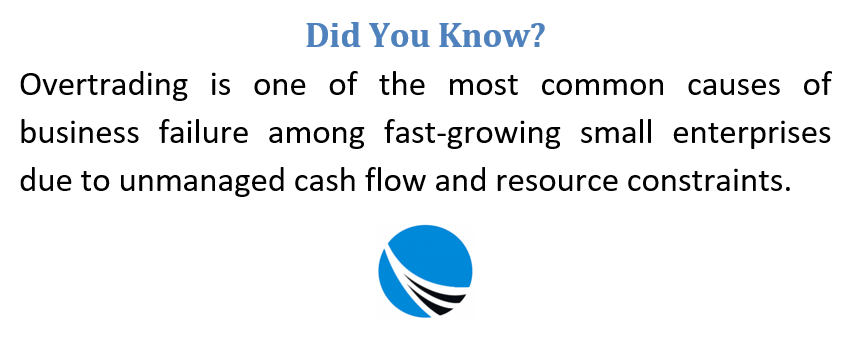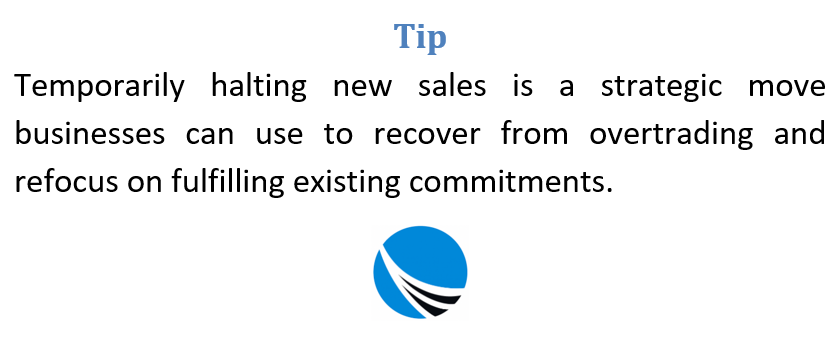Overtrading is a silent threat to many growing businesses. While it might initially seem like a positive sign—orders coming in, demand surging—the truth is more complicated. When a company stretches its financial and operational capacity too thin, it risks running into serious difficulties that can spiral out of control.
Let’s explore what overtrading really means, what causes it, and how a business can avoid or recover from it.

Defining Overtrading: What It Really Means
Overtrading happens when a business tries to grow too quickly without the necessary financial backing, resources, or infrastructure. The company may secure large or numerous orders but lacks the working capital, stock, or manpower to complete them effectively.
In these cases, business growth exceeds operational capacity. The consequences can be severe: late deliveries, missed payments, unhappy customers, and even legal trouble with suppliers or clients. In the worst scenarios, it can lead to insolvency.
Common Symptoms That Signal Overtrading
Several red flags often signal that a company is overtrading:
- Relying heavily on overdrafts or short-term credit
- Persistent cash flow shortages
- Late payments to and from the business
- Consistently low profit margins
- Struggles to meet order timelines
- Understaffing in critical departments
These indicators suggest that the business is operating at an unsustainable pace and is vulnerable to financial distress.

How Overtrading Unfolds: A Practical Illustration
Imagine a small company that begins securing large contracts back-to-back. To fulfill them, it places massive supply orders and hires temporary staff. But the payment terms for clients are 60 days, while suppliers demand payment in 30.
This mismatch leaves the company cash-strapped. Suppliers stop deliveries, unfinished orders pile up, and clients grow impatient. Eventually, the firm’s reputation declines, and new clients hesitate to place orders. Cash dries up, debts mount, and recovery becomes increasingly difficult.
Strategies to Prevent Overtrading
Preventing overtrading involves strong financial planning and operational control. Here are several effective tactics:
Keep Inventory in Check
Closely monitoring stock levels helps free up working capital and avoids unnecessary storage costs. Just-in-time (JIT) inventory management is one option, where businesses order goods only when needed. This approach minimizes waste and reduces the chance of overstocking.
Use Purchase Order Financing
Purchase order (PO) finance can help when a company has confirmed orders but lacks funds to pay suppliers. A third-party lender steps in to pay the supplier directly. When the customer pays, the lender takes their cut and the remainder returns to the business. This tool ensures the business can fulfill orders without using its own limited cash.
Consider Leasing Instead of Buying
Large equipment purchases can strain cash flow. Leasing or hire purchase spreads the cost over time. While leasing doesn’t transfer ownership, it allows access to essential machinery without a massive upfront payment. Hire purchase agreements can also help, giving eventual ownership after installment payments.
Tap Into Invoice Financing
Invoice financing allows a business to unlock capital tied up in unpaid invoices. Instead of waiting 30 or 60 days, a company can receive a cash advance—often up to 90% of the invoice value. Once the customer pays, the financing provider deducts their fees and returns the balance. This accelerates cash inflows and keeps operations moving.
Tackle Late Payments from Clients
Late payments are a leading cause of overtrading. A robust credit control process is essential. Conduct credit checks on new clients, ensure accurate invoicing, and follow up promptly when payments are overdue. Using invoicing software can automate reminders and track payment status. Businesses can also escalate severe cases to dispute resolution bodies or industry ombudsmen.
Reduce Operating Costs Strategically
Cutting unnecessary expenses can ease financial pressure. Options include:
- Sharing resources with partner businesses
- Downsizing office space or working remotely
- Switching to freelance or part-time contracts
- Eliminating non-essential subscriptions or services
- Booking travel in advance or opting for virtual meetings
Even small savings across various areas can make a meaningful difference.
Improve Supplier Relationships
Maintaining transparent communication with suppliers allows businesses to negotiate better terms. For instance, extended payment timelines can improve cash flow. Reliable suppliers may even offer discounts for volume or loyalty. If an existing supplier becomes inflexible, consider alternatives that offer more favorable terms without sacrificing quality.
Forecast and Track Cash Flow
Proactive financial forecasting is a critical defense against overtrading. Monthly or even weekly forecasts can highlight potential shortfalls early. This gives the business time to arrange funding or scale back spending. Use cash flow projections to inform business decisions, especially during high-growth periods or seasonal fluctuations.
What to Do if You’re Already Overtrading
If your business has slipped into overtrading, all is not lost. The key is to act swiftly and decisively. Here’s how to recover:
Rethink Your Growth Plan
A period of rapid expansion may have exposed flaws in your growth strategy. Review your original business plan and compare it to your current position. Ask yourself:
- Were our targets too ambitious?
- Did we underestimate the resources needed to scale?
- Have we diverted from our core strengths?
Realigning your goals and resetting expectations can help bring the business back into balance.
Pause Sales Activity Temporarily
Though it may seem counterintuitive, halting new sales temporarily allows your team to catch up with existing orders. This can help restore customer confidence and prevent a backlog from escalating. During the pause, consider collecting leads or waitlist signups to maintain future interest without adding operational pressure.
Review Your Product or Service Line
Too many products or services can dilute your resources. Evaluate your offerings and identify the most profitable or in-demand ones. Cutting underperforming lines allows the business to focus on what works best, simplifying operations and reducing complexity.
Adjust Pricing Strategically
Raising prices might reduce customer volume but can help balance supply and demand. Fewer orders at a higher margin are often easier to fulfill than many low-margin deals. However, changes must be communicated clearly to avoid alienating existing clients. Consider bundling or tiered pricing as more palatable adjustments.
Limit or Delay Expansion
If your business is overtrading, this is not the time to open new locations, hire more staff, or make major capital purchases. Scale back until your core operations stabilize. Postpone growth investments until your finances are healthy and existing demand is being met comfortably.
Improve Internal Processes
Operational inefficiencies often exacerbate overtrading. Audit your workflow, identify bottlenecks, and explore automation tools where possible. Streamlining internal systems can help your team work smarter, not harder—freeing up resources without additional hiring.
Seek Professional Guidance
In challenging times, consulting with a financial advisor or business consultant can provide clarity. These professionals offer objective insights and may suggest solutions not yet considered. If cash flow issues are critical, consider speaking with a turnaround specialist or restructuring advisor.
Rebuild Trust with Stakeholders
Whether it’s clients waiting on overdue orders or suppliers awaiting payment, communication is key. Keep stakeholders informed of your efforts to regain control. Honesty can preserve relationships even when operations are under stress.
Stay Disciplined with Credit and Lending
If you need external funding to recover from overtrading, approach it cautiously. Avoid high-interest or short-term loans that could worsen your situation. Instead, seek financing with manageable terms and use the capital strictly to resolve overtrading—such as finishing pending orders or consolidating debts.
Conclusion: Sustainable Growth Beats Speed
Overtrading is not simply about having too many customers—it’s about growing faster than your infrastructure, cash flow, and people can handle. While rapid success can be thrilling, sustainability is the real goal.
Through strategic planning, prudent financial management, and smart operational decisions, you can protect your business from the pitfalls of overtrading. And if you find yourself overwhelmed, take a step back, reassess your priorities, and make thoughtful changes that support long-term stability and growth.

Frequently Asked Questions about Overtrading
Why Is Overtrading Dangerous?
It can result in cash shortages, supplier disputes, poor customer service, reputational damage, and in extreme cases, business insolvency.
What Are the Warning Signs of Overtrading?
Signs include frequent overdraft use, delayed payments, inventory issues, narrow margins, and an overburdened workforce unable to meet rising demand.
How Can Inventory Monitoring Help Prevent Overtrading?
By aligning stock with actual demand and avoiding excess purchases, businesses can free up cash and avoid unnecessary storage costs.
What Financial Tools Can Help Manage Overtrading?
Tools such as purchase order financing, invoice financing, and lease/hire purchase agreements can provide working capital without straining internal funds.
How Should Late Payments Be Handled?
Implement credit checks, invoice accurately, use follow-up software, and maintain good customer relationships to reduce payment delays.
What Steps Should Be Taken If a Business Is Already Overtrading?
Pause new sales, reevaluate growth strategies, streamline product offerings, adjust pricing, and improve operational efficiency.
Can Overtrading Be Avoided During Business Growth?
Yes, by planning sustainable growth, monitoring cash flow, negotiating supplier terms, and not expanding faster than resources allow.

